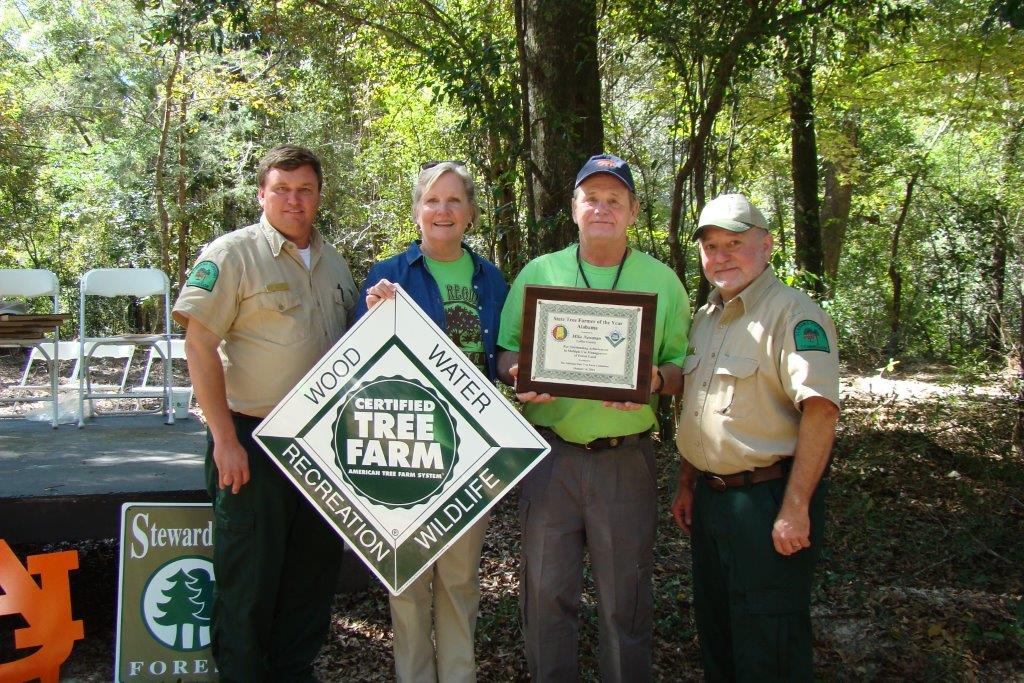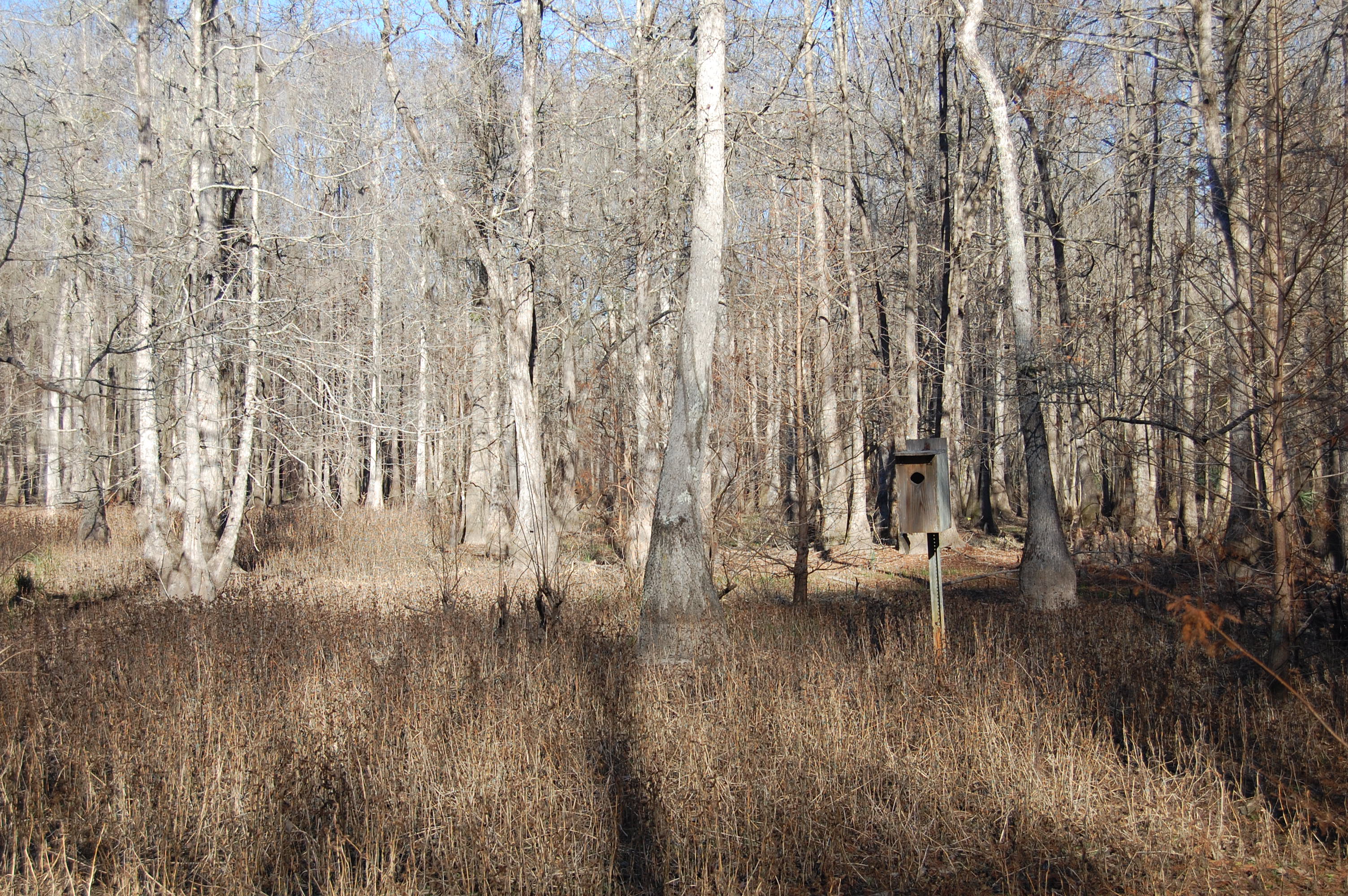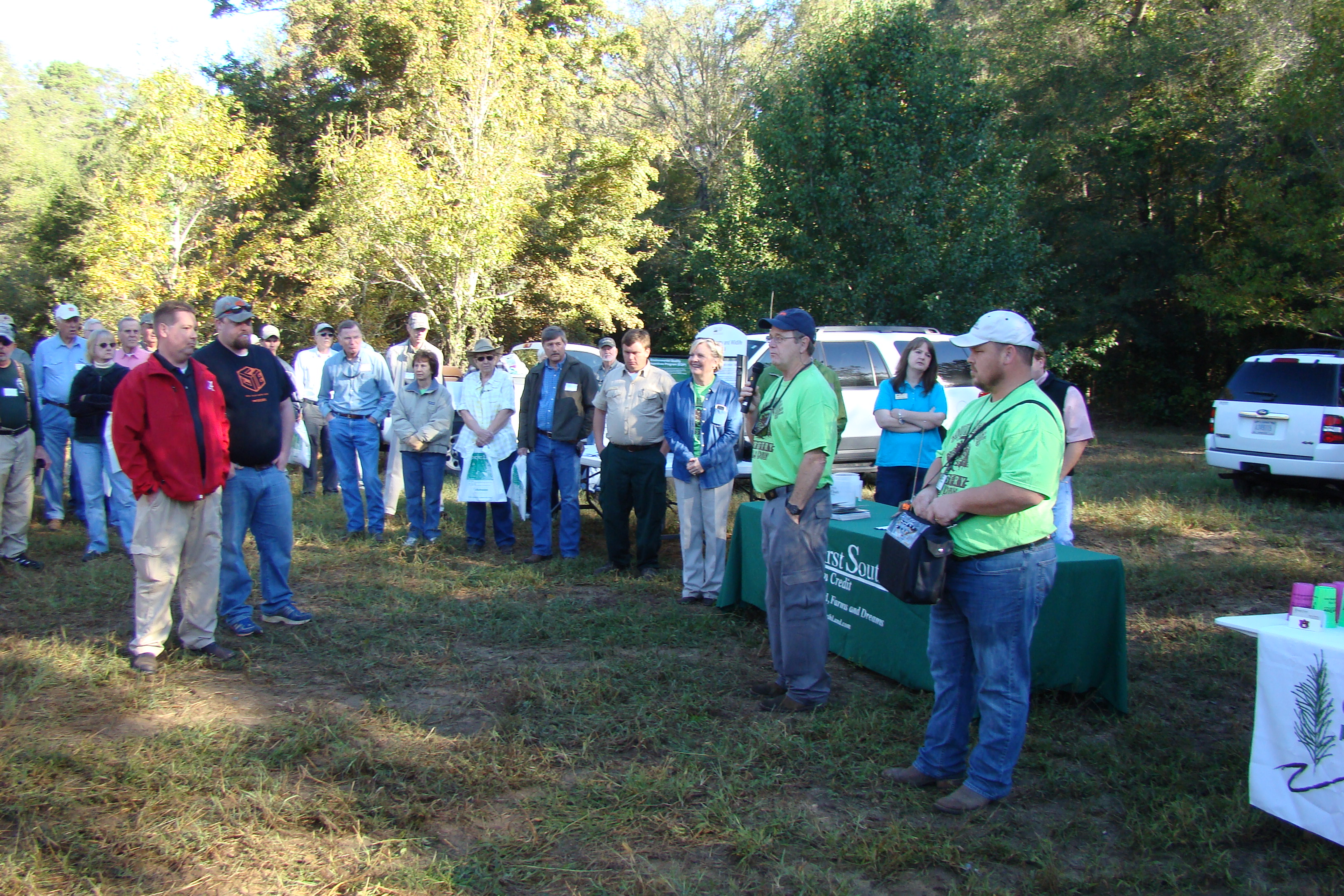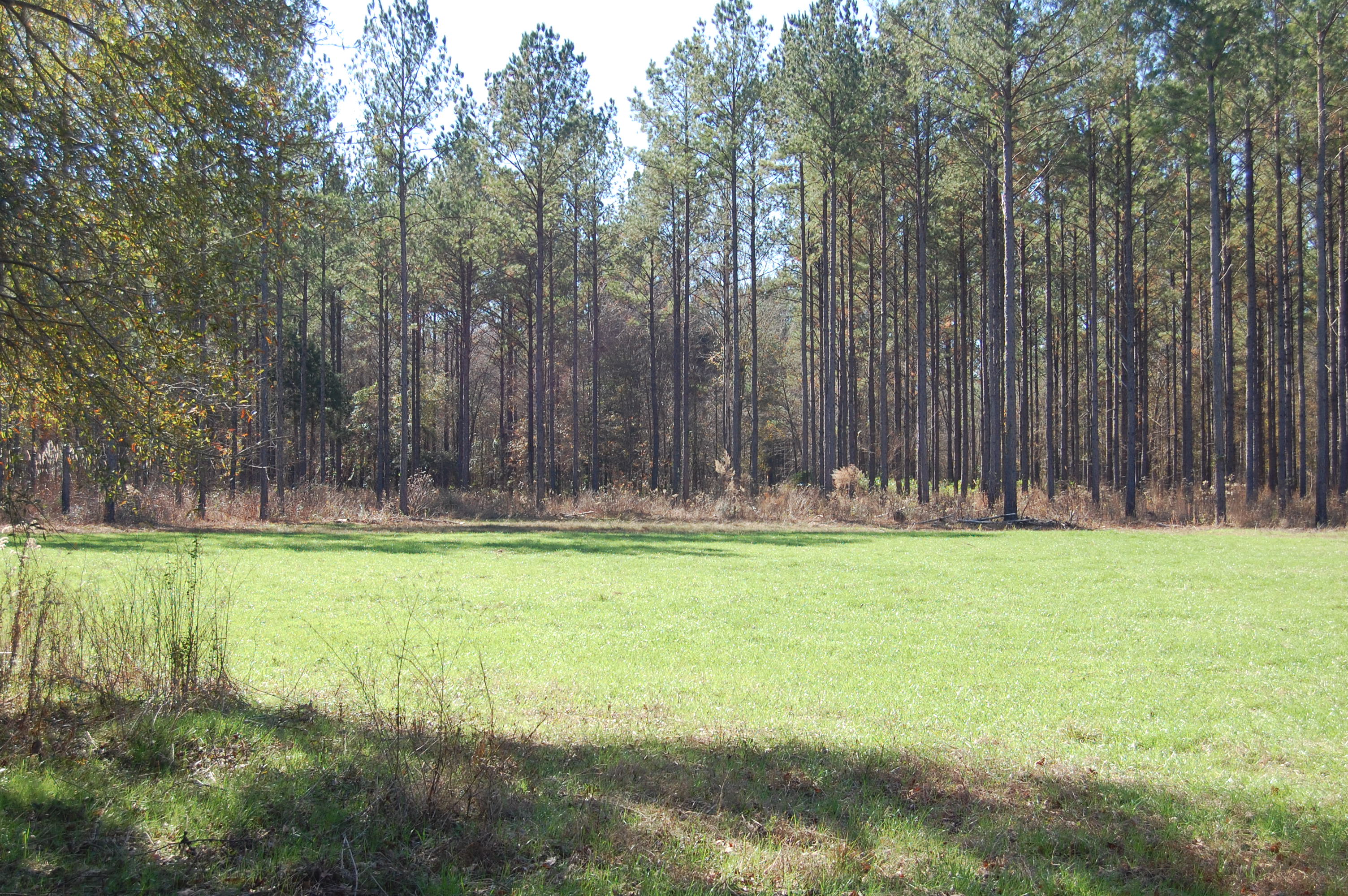Mike and Joan Newman of Alabama

What makes them outstanding?
The story of Mike and Joan Newman is a shining example of how good stewardship and management can result in a Tree Farm with multiple achievements and benefits. When the Newman’s purchased their property, the standing timber had been bought by a logger. The Newman’s practiced good stewardship by establishing and maintaining a Streamside Management Zone for erosion control, wildlife habitat, and aesthetics.
After the logger clear cut the timber, the Newman’s sought advice from forestry professionals and invited them to visit their property. They contracted with heavy equipment operators to install access roads and fire lanes. Wildlife openings were also created. Loblolly pines were planted on soils that would support them and various hardwoods were planted in wetland areas where appropriate.
In addition to reforestation and wildlife management, the Newman’s placed an emphasis in their land management plan on sharing their property with others. They maintain miles of forest trails and a pavilion on the property for others to enjoy. They have hosted youth hunts, Boy Scouts, church groups, and local military on their property. They also hosted the 2014 South Regional Forestry Field Day, where other landowners came and learned more about sustainable forestry practices.As with any landowner, the Newman’s have also had to adjust the management of their property when natural disasters have occurred, including three floods and 2 major hurricanes. These natural disasters have not discouraged Mike and Joan Newman. The excellent condition of their property is a reflection of their hard work and dedication to be good stewards of the land. As Mike often states: Nobody owns the land but God. We are all just caretakers to pass it down, hopefully in better shape than we received it.
Tree Farmer Story

Mike and Joan Newman purchased their property along the Pea River in 1987. The property sale was set up so they could either buy both land and timber, the land only or the timber only. Unsure whether they could afford to buy both land and timber, they decided to purchase the land and a local logger purchased the timber. As the logger began to clear cut the property, the Newman’s asked if a Streamside Management Zone (SMZ) was going to be left along the river. The logger replied, “If it’s not against the law then we will cut to the river bank."
Mike and Joan did not want that to happen, because they knew there should be a SMZ for erosion control, wildlife habitat, and aesthetics. They offered to pay the logger the value of the timber along the river so it would be retained. The logger agreed, but took advantage of the situation by charging more than the cruise indicated the timber was worth.However, the Newman’s knew a SMZ was needed to protect the river and willingly paid the higher price. The rest of the property was clear cut. Because the previous owner of the property lived out of town, the neighbors had gotten into the habit of going onto the property. The river also attracted young people for parties. Others had used the property as a garbage dump. In short, the Newman’s started managing land that had been clear cut and was being used as a garbage dump. Undaunted, they erected gates and placed fencing along the road frontage to prevent trespassing. This annoyed the neighbors who lost access to the property and resulted in some retaliatory vandalism.
To help them make improvements, the Newman’s sought advice from forestry professionals. They received recommendations and management plans from the NRCS, Alabama Forestry Commission, DCNR, Stone Container Corporation, and several forestry consultants. Following the advice they had received, the Newman’s also invited the advisers to visit their property and observe their progress. They contracted with heavy equipment operators to build access roads and fire lanes. Wildlife openings were also created. The clear cut was site prep prescribe burned. In the winter, loblolly pine trees were planted on soil types that would support them. When the loblolly pines were two years old, they were released by aerial spraying. Hardwoods were planted in some of the wetter areas. There was a low lying portion of the property that was turned into a permanent wetland for waterfowl. In conjunction with help from forestry professionals, Mike Newman oversees all of the management activities on their property including timber sales, reforestation, timber improvement practices, road maintenance, and wildlife plantings. Other than plantation planting, occasional mechanical site prep and helicopter spraying, most management activities have been performed by Mike, his friends, and family. The Newman’s practice good stewardship on their property and have aggressively managed their timberland to achieve multiple benefits.
Currently the land use is divided between planted loblolly pines, mixed pine hardwoods, bottomland hardwoods, planted hardwoods, wildlife openings, and a dove field.A road and fire lane system is maintained throughout the property to divide the various timber stands and also provide access. Loblolly pine stands have been selectively thinned as needed. Prescribed burning activities are conducted on a two to three year rotation and herbicides have been used to control undesirable competition and to enhance wildlife habitat.Hardwoods stands are still excluded from harvesting in order to serve as a SMZ against erosion. These SMZ’s consist of good mast producing trees along creek and river bottoms and drainage ditches throughout the property, which provide cover, travel corridors, roosting sites, and winter food source for wildlife.Several acres of wildlife food plots are planted and maintained annually. Hard and soft mast producing trees have been planted throughout the property to provide an additional food source for wildlife.
Mr. Newman plants a field with sunflowers, sesame, and corn which is used for dove hunting. Wood duck boxes and bluebird boxes were constructed and placed in strategic areas. Several miles of forest trails are maintained and used for hiking. Also a pavilion has been built to be used as a picnic area for family gatherings. The pavilion offers a beautiful view of the Pea River.Mike and Joan take pleasure in sharing their property with others. They invite landowners to visit their property to observe forest management activities and learn how to implement them. They hosted the 2014 South Alabama Regional Forestry Field Day. Local Boy Scout troops visit the property to earn forestry related merit badges. Boy Scouts also attend a camporee on the Pea River. Mr. Newman hosts the First Baptist Church father/son camp out and youth Sunday school class on the Pea River. He also sponsors youth deer and turkey hunts. At least 11 youngsters have harvested their first deer on the Newman’s property. Two young hunters have also harvested their first turkeys. As a fundraising event, the Wiregrass United Way auctions a deer hunting trip to the Newman’s property. They hosted a Texas A & M style bonfire for helicopter flight students stationed at Fort Rucker Military Base. Mike often states, “Nobody owns the land except God, we are all just caretakers to pass it down- hopefully in better shape than we received it.”Since the Newman’s purchased their property, they have endured 3 floods (most recently Christmas 2015) and 2 major hurricanes. But these natural disasters have not discouraged Mike and Joan.The excellent condition of the Newman property reflects the many hours of planning and hard work put in by them. Mike and Joan’s efforts have led to their property being certified as a State of Alabama Treasure Forest, certified Stewardship Forest, and certified Tree Farm. Their property was Coffee County’s 2007 Forestry Farm City winner.As the 2014 Alabama Tree Farmers of the Year, Mike and Joan are shining examples of who Tree Farmers are, and are ideal candidates for ATFS National Tree Farmers of the Year.

Wood
Timber production is a secondary objective on this property, with a goal to increase the income of timber through proper forest management techniques. Pine stands have been selectively thinned as needed and prescribe burning and herbicides have been used to control undesirable competition and to enhance wildlife habitat. Hardwoods stands have been excluded from timber harvesting and prescribe burning in order to enhance the wildlife population and serve as a Streamside Management Zone against erosion. The Newman's practiced reforestation and actively managed the remaining standing timber on the property. The Newman's conducted a second thinning in 2012 on approximately 41 acres of planted Loblolly pine. Products harvested included pulpwood and canter wood. Since the initial clear cut done at time of purchase, no clear cut activity has been done on the property.
Water
One of the first management decision the Newman's made for this property was to establish a Streamside Management Zone. Designated Bottomland Hardwoods were utilized to reduce erosion and protect water quality. SMZs are excluded from timber harvesting and prescribe burning activities. These SMZ's consists of mast producing trees along creek and river bottoms and drainage ditches throughout the property, which provide cover, travel corridors, roosting sites, and winter food source for wildlife.
Wildlife
The Newman’s primary objective is to enhance and maintain the wildlife population through maintaining wildlife food plots and keeping adequate cover for desired wildlife species. Hardwoods stands have been excluded from timber harvesting and prescribe burning in order to enhance the wildlife population and serve as a Streamside Management Zone against erosion. Several acres of wildlife food plots are planted and maintained annually. Hard and soft mast producing trees have been planted throughout the property to provide an additional food source for wildlife. Mr. Newman plants a field annually with sunflowers, sesame, and corn which is used for dove hunting.
Recreation
Several miles of forest trails are maintained that are used by the Newman family for walking. Also a pavilion has been constructed to be used as a picnic area for family gatherings. The pavilion provides a beautiful view of the Pea River. Various groups and organizations, including church groups, boy scouts, civic groups, and military, are allowed to use the property for camping and recreation.


